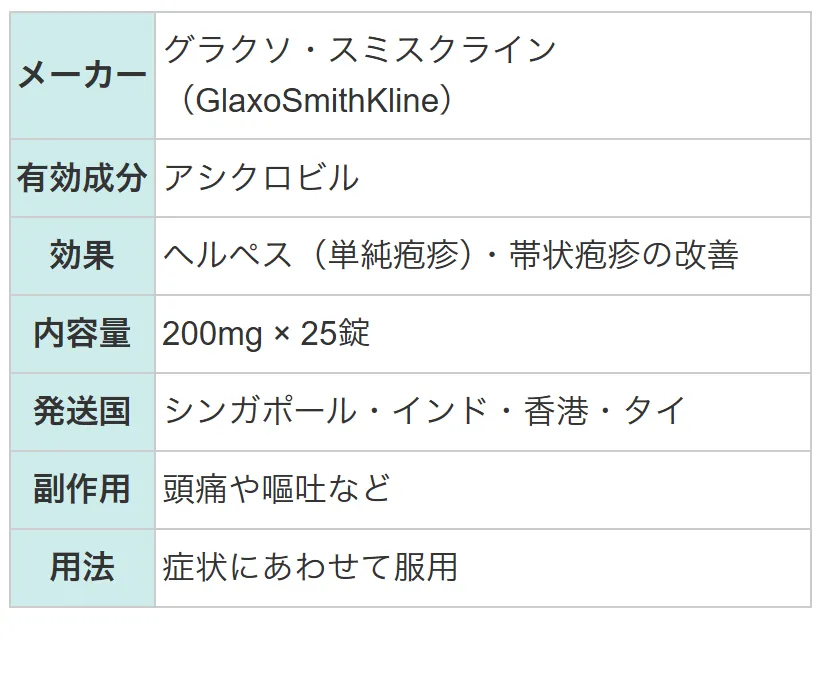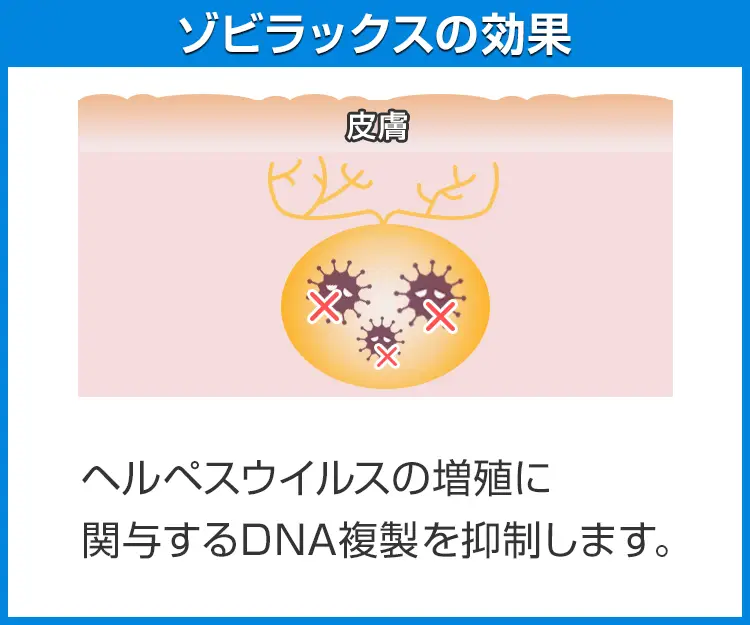塗るタイプのより飲むタイプの方が自分には合ってました、症状が治まるまでも飲むタイプの方が早かった気がします。僕はこっちの方を今後も利用すると思います。とりあえずもう一箱買いました。

左記クレジットカード、銀行振込、コンビニ決済に対応







更新日:2025/6/15
ゾビラックスは、イギリスに本社がある世界的な製薬メーカーのグラクソ・スミスクライン(GlaxoSmithKline)が製造を手がけている抗ウイルス薬です。
性器ヘルペスや口唇ヘルペスの治療に使える他、高用量の800mg錠を選べば1回1錠(1日5回)の服用で帯状疱疹を改善させることができます。
| メーカー | グラクソ・スミスクライン(GlaxoSmithKline) |
|---|---|
| 有効成分 | アシクロビル |
| 効果 | ヘルペス(単純疱疹)・帯状疱疹の改善 |
| 副作用 | 頭痛や嘔吐など |
| 用法 | 症状にあわせて服用 |
ゾビラックスの有効成分は、ヘルペスウイルスによる疾患に効果を発揮するアシクロビルです。ヘルペスウイルスの増殖に欠かせないDNA合成を阻害することで、症状を改善へと導きます。
ゾビラックスには、成分配合量が異なる200mg錠、400mg錠、800mg錠の3種類があります。

| 個数 | 販売価格(1錠あたり) | 販売価格(箱) | ポイント | 購入 |
|---|---|---|---|---|
| 25錠 | 162円 | 4,060円 | 121pt | |
| 50錠 | 113円 | 5,660円 | 169pt |
| 個数 | 販売価格(1錠あたり) | 販売価格(箱) | ポイント | 購入 |
|---|---|---|---|---|
| 50錠 | 155円 | 7,760円 | 232pt | |
| 100錠 | 127円 | 12,760円 | 382pt |
| 個数 | 販売価格(1錠あたり) | 販売価格(箱) | ポイント | 購入 |
|---|---|---|---|---|
| 25錠 | 250円 | 6,260円 | 187pt | |
| 50錠 | 175円 | 8,760円 | 262pt |






①1万円以上で送料無料
1回の注文で10,000円以上だった場合、1,000円の送料が無料となります。
まとめ買いをすると1商品あたりのコストパフォーマンスが高くなるためおすすめです。
②プライバシー守る安心梱包
外箱に当サイト名や商品名が記載されることはないため、ご家族や配達員など第三者に内容を知られることは御座いません。

③100%メーカー正規品取り扱い
当サイトの商品は100%メーカー正規品となっており、第三者機関による鑑定も行っております。
商品の破損などがあった場合は再配送などにて対応させて頂きますので、ご連絡頂ければ幸いです。

④いつでも購入可能 処方箋不要
サイト上では24時間いつでもご注文を受けております。
また、お電話によるご注文も受け付けておりますのでネットが苦手な方はお気軽にどうぞ。

⑤商品到着100%
商品発送後はお荷物の追跡状況が分かる追跡番号をご案内させて頂きます。
郵便局には保管期限がありますのでご注意ください。
・自宅配達で不在だった場合の保管期限・・・16日間前後
・郵便局留めとした場合の保管期限・・・7~30日間

⑥コンビニ決済利用可能
ご近所のコンビニにていつでもお支払可能です。
セブンイレブンに限り店舗での機械操作を必要とせず、手続き完了後に表示されるバーコードや払込票番号をレジに提示することでお支払い頂けます。

ゾビラックス 200mg x 25錠
4,060円
ポイント:121pt
10,000円以上購入で送料無料
在庫あり

塗るタイプのより飲むタイプの方が自分には合ってました、症状が治まるまでも飲むタイプの方が早かった気がします。僕はこっちの方を今後も利用すると思います。とりあえずもう一箱買いました。
普段、ゾビラックスはクリームのほうを使っています。たまには錠剤も試してみるかと思い、購入して飲んでみましたが、副作用が結構気になりました。私の体にはクリームのゾビラックスのほうが合っていそうですし、使い心地もわかったので、クリームに戻します。
ゾビラックスは、単純ヘルペスウイルス1型・2型、そして水痘・帯状疱疹ウイルスに対して強い効果があります。ウイルスが活発に増える段階で使うと特に有効で、感染の広がりを抑えることができます。
ヘルペスの再発を防ぐ目的でも使用されます。特に、骨髄移植後や免疫が下がっているときにヘルペスの発症を抑える効果が認められており、予防的に使われることもあります。
帯状疱疹の治療にもゾビラックスは使われており、ウイルスの増殖を抑えて痛みや皮膚症状の悪化を防ぎます。発疹が出てから5日以内に飲み始めると、より高い効果が期待できます。
ゾビラックスはウイルスのDNAを複製する酵素の働きをブロックして増殖を止めます。ウイルスがいる細胞だけに効くため、体への影響は比較的少ないとされています。
通常、単純ヘルペスの場合は1回200mgを1日5回、帯状疱疹では1回800mgを1日5回飲みます。毎日決まった時間に飲むことで、ウイルスの増殖をしっかり抑えやすくなります。
アシクロビルは1日5回、できるだけ等間隔(就寝時を除く)で飲むのが基本です。朝食後、昼食後、午後のおやつ、夕食後、就寝前などのリズムで飲むと続けやすくなります。
食事の影響は大きくないため、食前でも食後でも問題はありません。ただし、胃の不快感を避けたい場合には、食後の服用が勧められることがあります。
ウイルスは見た目の症状がなくても体内に残っていることがあるため、処方された日数分を飲み切ることが大切です。途中でやめると再発のリスクが高まります。
一部の薬と一緒に使うとゾビラックスが体に長く残ってしまい、副作用が出やすくなることがあります。とくに胃薬や免疫抑制剤などを使っている方は服用の間隔などを事前に医師と確認してください。
吐き気や下痢、腹痛や頭痛などの軽い副作用が見られることがあります。これらは一時的で自然に治まることが多いですが、長引いたりする場合は医師に相談するようにしましょう。
まれに腎臓や脳への影響が出ることがあります。高い熱や意識の混乱、手足のしびれ、尿が出にくいなどの症状が出た場合はすぐに受診が必要です。特に体調を崩しやすい方や高齢の方は慎重に使う必要があります。
ゾビラックスは腎臓から排出されますが、体の水分が少ないと腎臓に負担がかかり、障害を起こすおそれがあります。脱水を防ぐことで副作用のリスクを下げるため、こまめな水分摂取が勧められています。
| 1日の服用回数 | 5回 |
|---|---|
| 1回の服用量 | 200mg |
| 服用のタイミング | 朝食後、昼食後、午後4時頃、夕食後、就寝前 |
| 服用期間 | 4時間 |
| 1日の服用回数 | 5回 |
|---|---|
| 1回の服用量 | 200mg |
| 服用のタイミング | 朝食後、昼食後、午後4時頃、夕食後、就寝前 |
| 服用期間 | 4時間 |
| 1日の服用回数 | 5回 |
|---|---|
| 1回の服用量 | 800mg |
| 服用のタイミング | 朝食後、昼食後、午後4時頃、夕食後、就寝前 |
| 服用期間 | 4時間 |
| 商品名 | バルシビル | アシビルDT | リディノックス | ゾビラックスクリーム | バクスバイア | ゼリトレックス | アシビル眼軟膏 |
|---|---|---|---|---|---|---|---|
| 商品画像 |  |  |  |  |  |  |  |
| 特徴1 | 性器ヘルペスを改善させる飲み薬 | ・インドで有名なシプラ社が販売 | ・ヘルペスウイルスの増殖を抑制 | ・単純疱疹や帯状疱疹を改善 | ・ヘルペスウイルスを死滅させる | ・バルトレックス錠と並ぶほどの優れた効果がある | ・ジェネリックだから治療費の負担を抑えられる |
| 特徴2 | 1/2カットでコストダウン可能 | ・飲塗り薬よりも効き目が強い | ・ヘルペスウイルスによる角膜炎を改善 | ・ヘルペスウイルスの増殖を抑制 | ・服用回数を抑えられる | ・ヘルペスウイルスによる症状を効果的に改善する | ・国内でも処方されている薬のジェネリックだから安全 |
| 内容量 | 500mgx15錠 | 200mgx100錠 | 0.1%10mlx1本 | 5% 2gx1本 | 1000mg21錠x1箱 | 500mg42錠x1箱 | 3%5gx1本 |
| 価格 | 3,800円 | 7,160円 | 3,660円 | 4,260円 | 7,360円 | 8,460円 | 3,660円 |
| 0.1%〜1%未満 | 0.1%未満 | 頻度不明 | |
| 皮膚 | 投与部位の刺激感、接触皮膚炎、そう痒、紅斑性発疹 | 投与部位の疼痛、皮膚乾燥 | 灼熱感、皮膚薄片剥離 |
| 過敏症 | 血管性浮腫、蕁麻疹 |
本製品は海外製のため、期限表記が日本と異なる場合がございます。
パッケージ裏面や側面、シートなどに以下のような表記がされています。
| EXP | 使用期限 例:EXP 12/2025→2025年12月まで使用可 |
|---|---|
| MFG または MFD | 製造日 例:MFG 03/2023 |
| BEST BEFORE | 品質が最も安定している目安日 |


※国や製品により日付の並び(例:月/年、日/月/年)が異なる場合がありますのでご注意ください
EXP(Expiry Date) の表記がなく、MFG または MFDしか記載がないケースがあります。
この場合は MFG(MFD) から2~3年が使用期限の目安です。
※「LOT」や「BATCH」の表記は製造番号であり期限ではありません。

パッケージ例となります。
商品やご注文単位によってはシート単位でのお届けとなる場合が御座います。
外箱に当サイト名や商品名が記載されることはないため、ご家族や配達員など第三者に内容を知られることは御座いません。
塗るタイプのより飲むタイプの方が自分には合ってました、症状が治まるまでも飲むタイプの方が早かった気がします。僕はこっちの方を今後も利用すると思います。とりあえずもう一箱買いました。
唇に水泡ができやすいので、1番効果のあったこちらの商品を継続して購入しています。安いし、しっかり改善されるし、副作用も自分は感じないのでベストですね。
ここで買えたことで周囲にヘルペスであることを知られずに改善できました!病院に行くとどこかから知られる可能性が0ではないので、通販なら安心です。
持病か?ってくらいヘルペスになる、この薬、このサイトと出会ってなければまた処方してもらいに行かなければならないところだ。
何故か度々ヘルペスになるのでもう通院が面倒な時にこちらのサイトを見つけました。面倒な手間なくヘルペスを治めることが出来るのでお礼しかありません。ほぼ常備薬かってくらい買ってます。
商品口コミの投稿は会員のみ行えるようになっております。
お手数ですが会員ログインの上でご投稿頂きますようお願いいたします。
口コミをご投稿頂いたお客様にはポイントをプレゼントさせて頂いております。
文章のみであれば100ポイント、文章+写真付きのものは300ポイントをプレゼントさせて頂きます。
規約や詳細などはこちらをご確認くださいませ。